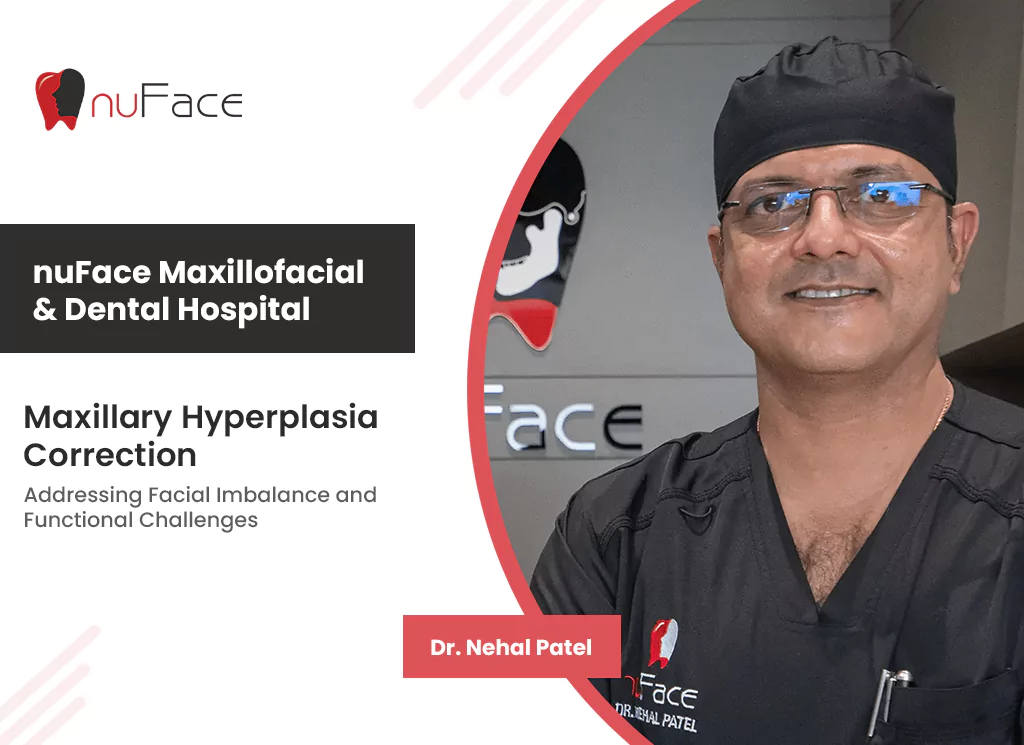Addressing Facial Imbalance and Functional Challenges
Maxillary hyperplasia, also known as vertical maxillary excess (VME), is a condition where the upper jaw grows excessively, causing both aesthetic and functional problems.
Patients with maxillary hyperplasia often display a “gummy smile,” facial elongation, and bite problems, all of which can affect their appearance, oral health, and self-confidence.
Addressing this condition requires a highly skilled team and advanced surgical interventions to restore facial harmony.
At NuFace Maxillofacial and Dental Hospital, led by Dr. Nehal Patel, we provide comprehensive maxillary hyperplasia correction services.
Whether you are a patient in India or from abroad, we ensure personalized, cutting-edge treatment to restore balance and function to your facial structure.
What is Maxillary Hyperplasia?
Maxillary hyperplasia occurs when the upper jaw (maxilla) grows too much, creating an imbalance in facial proportions. This can lead to several noticeable symptoms:
Gummy smile:
Excess gum tissue is visible when smiling due to the overgrowth of the maxilla.
Elongated midface:
The middle part of the face appears too long, causing facial asymmetry.
Malocclusion:
The abnormal growth can result in bite problems, often with the lower jaw not aligning properly with the upper jaw.
Functional issues:
Causes of Maxillary Hyperplasia
The exact cause of maxillary hyperplasia can vary, but the condition often arises due to:
Genetics:
Family history of facial imbalances can contribute to the development of maxillary hyperplasia.
Syndromic conditions:
Certain genetic disorders, such as craniofacial syndromes, can lead to abnormal jaw growth.
Developmental factors:
Maxillary Hyperplasia Correction Surgery
Maxillary hyperplasia is treated through orthognathic surgery, specifically Le Fort osteotomy, which involves repositioning the upper jaw.
The goal of the surgery is to restore facial harmony, correct bite issues, and improve overall oral function.
Le Fort I Osteotomy
The most common procedure for maxillary hyperplasia correction is Le Fort I osteotomy, where the surgeon makes a horizontal cut across the maxilla to allow for vertical repositioning.
Depending on the patient’s unique needs, the maxilla may be moved upward or shortened to correct the gummy smile and improve facial symmetry.
During the surgery, titanium plates and screws are used to secure the jaw in its new position, ensuring stability and long-term results.
The procedure is usually performed under general anesthesia, and patients typically stay in the hospital for a couple of days.
Gummy Smile Correction:
For patients with severe gummy smiles, additional soft tissue management may be necessary to reduce the amount of visible gum tissue.
This can involve gingivectomy (removal of excess gum tissue) or crown lengthening to create a more aesthetically pleasing smile.
Orthodontic Treatment:
Most patients undergoing maxillary hyperplasia correction will also require pre- and post-surgical orthodontics.
Braces or aligners are used to move the teeth into the correct position, ensuring that the bite aligns properly after surgery.
This combined approach leads to optimal functional and aesthetic outcomes.
Recovery and Post-Operative Care
Initial recovery:
Swelling and discomfort are common in the first few days after surgery. Most patients will be prescribed pain medications to manage this.
Soft diet:
A soft or liquid diet is recommended for several weeks to avoid putting stress on the healing jaw. Proper nutrition plays a key role in recovery.
Post-surgical appointments:
Follow-up visits with Dr. Nehal Patel and the team are crucial to monitor healing progress and ensure the stability of the corrected jaw.
Speech and chewing improvement:
Over time, patients will notice significant improvements in their bite alignment, chewing ability, and speech function.
Full recovery may take several months, but most patients can return to normal activities after a few weeks.
Benefits of Maxillary Hyperplasia Correction
Correcting maxillary hyperplasia provides both functional and aesthetic benefits:
Enhanced facial appearance:
Restoring facial symmetry and reducing the gummy smile improves self-confidence and overall facial aesthetics.
Better oral function:
Proper alignment of the jaws improves chewing, speaking, and even breathing, leading to an enhanced quality of life.
Long-term results:
The surgical correction is designed to provide permanent improvements in facial structure, making it a lasting solution for patients suffering from maxillary hyperplasia.
Psychological and Social Impact
Living with maxillary hyperplasia can significantly affect a person’s self-esteem and social interactions.
The gummy smile and facial elongation often cause patients to feel self-conscious about their appearance, leading to psychological distress and social anxiety.
By undergoing corrective surgery, patients not only improve their facial aesthetics but also regain confidence in their appearance and social interactions.
At NuFace Maxillofacial and Dental Hospital, our patients have shared positive feedback on how maxillary hyperplasia correction has transformed their lives.
We take pride in providing comprehensive care and ensuring each patient feels supported throughout their surgical journey.
Why Choose NuFace Maxillofacial and Dental Hospital?
As a trusted institution for maxillofacial surgery, NuFace Maxillofacial and Dental Hospital offers patients the most advanced treatments for maxillary hyperplasia correction.
Dr. Nehal Patel and his experienced team use state-of-the-art technology such as 3D imaging and virtual surgical planning to create personalized treatment plans for each patient.
Our hospital is equipped with modern facilities that ensure the best possible outcomes for both Indian and international patients.
Whether it’s improving facial aesthetics or addressing functional concerns, NuFace is committed to helping patients achieve their desired results.
Connect with Us
Interested in learning more about maxillary hyperplasia correction?
Contact us at NuFace Maxillofacial and Dental Hospital to schedule a consultation with Dr. Nehal Patel and explore the right treatment options for you.






